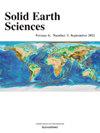Petrography and geochemistry of alkaline rocks from Michni (Warsak) area, NW Himalayas, Pakistan: Insights into petrogenesis and tectonic setting
IF 2
4区 地球科学
Q3 GEOSCIENCES, MULTIDISCIPLINARY
引用次数: 0
Abstract
The Michni area within the Warsak complex that is part of the Peshawar plain alkaline igneous province (PPAIP) in NW Pakistan, hosts a diverse suite of alkaline and carbonatitic rocks whose origin and evolution remain poorly constrained. This study focuses on this locality due to its complex lithological assemblage and the first discovery of carbonatite intrusions in the area, which fills a significant gap in the regional petrogenetic framework. Detailed fieldwork, petrographic analysis, and whole-rock geochemistry (XRF-based major and trace elements) were employed to investigate the petrogenesis and tectonic setting of these rocks. The intrusive suite includes pyroxenite, melteigite, ijolite, urtite, nepheline syenite, fenite, and both calcio- and ferro-carbonatites. Geochemical data reveal strong silica undersaturation and systematic fractionation trends, indicating magmatic differentiation from a shared parental magma. Pervasive fenitization and secondary phases such as cancrinite, phlogopite, and carbonate suggest metasomatic alteration driven by late-stage carbonatitic fluids. While petrographic and geochemical coherence supports a potential genetic link between silicate and carbonatite suites. This study enhances understanding of the magmatic and metasomatic evolution in PPAIP and recommends future high-resolution isotopic and mineral chemical analyses to further constrain magma source characteristics and alteration processes.
巴基斯坦西北喜马拉雅Michni (Warsak)地区碱性岩的岩石学和地球化学:岩石成因和构造背景的启示
位于巴基斯坦西北部白沙瓦平原碱性火成岩省(PPAIP)的Warsak复合体内的Michni地区拥有多种碱性和碳酸盐岩,其起源和演化仍不清楚。该区岩性组合复杂,首次发现碳酸盐岩侵入体,填补了区域成岩格局的重要空白。通过详细的野外调查、岩石学分析和全岩地球化学(基于xrf的主微量元素)研究了这些岩石的岩石成因和构造背景。侵入岩组包括辉石岩、熔辉岩、铁辉岩、黑钨矿、霞石正长岩、白云石以及钙碳酸盐和铁碳酸盐。地球化学数据显示石英欠饱和强,分馏趋势系统,表明岩浆分异来自一个共同的母岩浆。普遍存在的磷化作用和次生相,如癌质岩、云母岩和碳酸盐,表明晚期碳酸盐流体驱动的交代蚀变。而岩石学和地球化学的一致性支持硅酸盐和碳酸盐岩层之间潜在的遗传联系。该研究提高了对PPAIP岩浆和交代演化的认识,并建议未来进行高分辨率同位素和矿物化学分析,以进一步约束岩浆来源特征和蚀变过程。
本文章由计算机程序翻译,如有差异,请以英文原文为准。
求助全文
约1分钟内获得全文
求助全文
来源期刊

Solid Earth Sciences
GEOSCIENCES, MULTIDISCIPLINARY-
CiteScore
3.60
自引率
5.00%
发文量
20
审稿时长
103 days
 求助内容:
求助内容: 应助结果提醒方式:
应助结果提醒方式:


